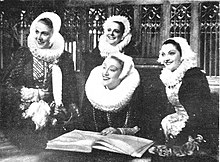
The men of the town grow increasingly paranoid of Spaniards as the women are free to run the stores and inns. The women from the outset take on a new set of sexual liberation in juxtaposition to the rape and pillaging stewed up from the men at the beginning of the film.
[Background and Production] The use of large paintings in the background of the film forced the disportioncate perspective that is a common motif in throughout the film.[1]
- ^ Smoodin, Eric (2017). "Introduction: French Cinema at the Margins". Framework: The Journal of Cinema and Media. 58 (1–2): 33–37. doi:10.13110/framework.58.1-2.0033. ISSN 0306-7661.
Things that can be added: The Actresses: Lyne Clevers (also in Le Grand Jeu), Maryse Wendling, Ginette Gaubert (the main supporting trio of women in the film) do not have an article.
- Key piece; Maryse Wendling became a Nun shortly after the completion of Carnival in Flanders.[1]
Cinematography
editThe cinematographer for this film was frequent Jacques Feyder collaborator Harry Stradling Sr. A well-known cinematographer for films such as A Streetcar Named Desire, Funny Girl, and Alfred Hitchcock’s Mr. & Mrs. Smith.[2] He came over to France due to the restrictions to two-reelers[3], or films with a runtime of 20 minutes, in Hollywood. In France he would work on a number of Jacques Feyder’s films.
Much of the themes of the film are shown through the subtle camerawork Stradling bought to the picture. These range from lines in the set or poles separating the Duke and his wife, showing the audience the distance between the characters. In the imaginary pillaging of the town a wide shot is used to allow the viewer to take in all the destruction but also distance from the violence to keep the sarcastic nature of the sequence intact. The sequence also includes many camera movements such as pans, tilts or tracking shots to hide some of the more extreme acts that are suggested as women are being dragged away. The use of wide shots also aids in reinforcing the idea of a Flemish painting. Shots such as windmills on green pastures or all the activity happening in the town for preparation for the carnival.
| This is the sandbox page where you will draft your initial Wikipedia contribution.
If you're starting a new article, you can develop it here until it's ready to go live. If you're working on improvements to an existing article, copy only one section at a time of the article to this sandbox to work on, and be sure to use an edit summary linking to the article you copied from. Do not copy over the entire article. You can find additional instructions here. Remember to save your work regularly using the "Publish page" button. (It just means 'save'; it will still be in the sandbox.) You can add bold formatting to your additions to differentiate them from existing content. |
Article Draft
editLead
editInclusion of: Created during the poetic realism period in 1930s France.
Article body
editReferences
edit- ^ "Noted French Actress Has Become a Nun". Cathedral Chronicle. 1936-02-01. Retrieved 2023-04-11.
- ^ "In Memoriam: Harry Stradling, Jr., ASC (1925-2017) - The American Society of Cinematographers (en-US)". theasc.com. Retrieved 2023-04-27.
- ^ Kuhn, Annette; Westwell, Guy (2012-12-20), "two-reeler", A Dictionary of Film Studies, Oxford University Press, doi:10.1093/acref/9780199587261.001.0001/acref-9780199587261-e-0737;jsessionid=720e55b07afa7cb174e04d10944d0b43, ISBN 978-0-19-958726-1, retrieved 2023-04-27